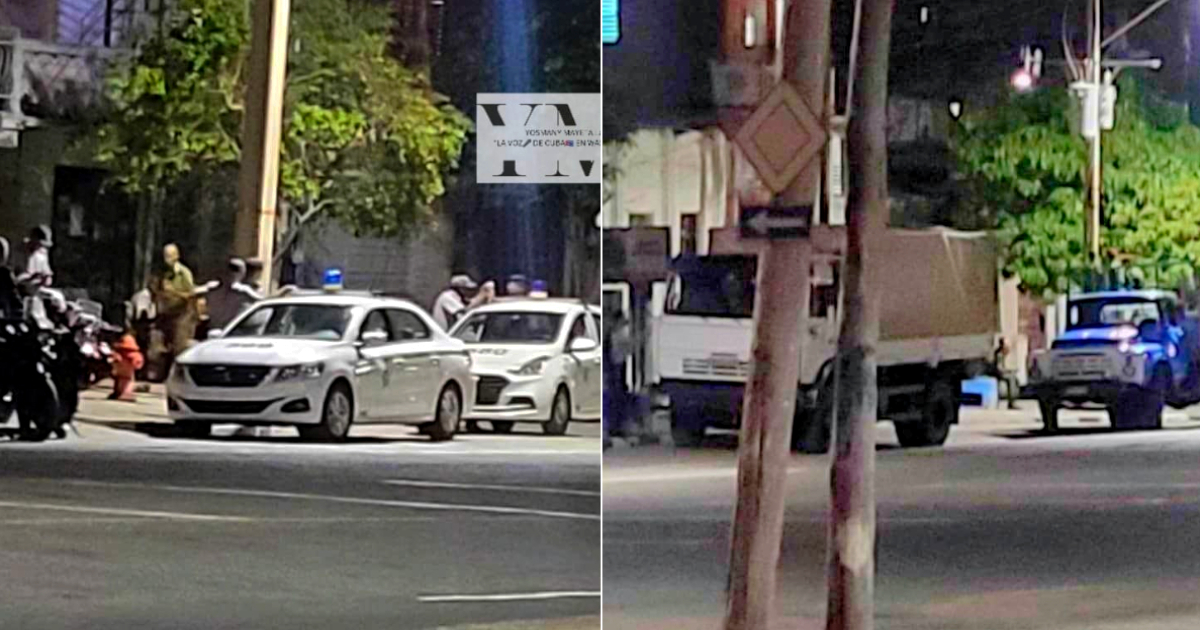A massive police deployment took place this Wednesday in Santiago de Cuba due to fears of popular protests, according to reports from social media users who shared images of vehicles and repressive agents on the city's streets.
"Military convoy takes to the streets of Santiago de Cuba over fears of protests amid popular discontent," reported independent journalist Yosmany Mayeta Labrada on his social media, citing his own sources and anonymous informants.
Images shared in his post showed trucks, patrols, and a large number of agents from the National Revolutionary Police (PNR) and special troops from the Ministry of Interior (MININT), known as "black berets."
"Many followers report that several military convoys, with police, 'black berets,' and cage cars, are stationed in various peripheral neighborhoods of Santiago de Cuba and along the central Carretera del Morro, the epicenter of the popular protest on March 17 (17M)," the journalist stated.
He also specified that the images shared corresponded to the deployment of repressive forces on Carretera del Morro "in front of the Eduardo Chibás monument and near the headquarters of the Communist Party in District #3, Antonio Maceo."
The photographs, taken from a considerable distance and at night, show a deserted city street filled with vehicles from the repressive forces.
Mayeta Labrada indicated that other convoys were stationed "near Avenida Martí and in the Altamira neighborhood, home to the Patriotic Union of Cuba (UNPACU), an opposition organization led by political prisoner and prisoner of conscience, José Daniel García Ferrer."
"The pressure cooker is about to explode!" concluded the independent journalist, urging his followers to send graphic testimonies and reports about the massive police presence in Santiago de Cuba.
The energy crisis worsening in Cuba, which manifests in frequent and prolonged blackouts, is once again straining the social landscape, with increasingly evident expressions of discontent among citizens.
The regime is aware of this and even anticipated it, as shown by the MININT on their social media in mid-April. According to the regime's primary repressive institution, the blame for this potential scenario lies with the United States government and its politicians who incite public disorder.
"The United States launches new attempts to 'heat up' the streets during the summer, taking advantage of the complex situation the country is experiencing, according to the latest interests of their intelligence agencies to generate attacks against Cuba, in what they call Operation 11.7.24," said the MININT on the social network X.
Determined to ignore the legitimacy of Cuban protests, closed to any dialogue with civil society, denying the recognition and enforcement of human rights in Cuba, especially freedom of the press, expression, and association, and betting their stay in power on strategies of confrontation, entrenchment, and repression, the Cuban regime is solely responsible for potential uprisings similar to those of July 11 (11J) and March 17 (17M).
On the last occasion, the spark that ignited in Santiago de Cuba spread to other locations, such as Bayamo and Cárdenas. Although the protesters demonstrated spontaneously and peacefully, the regime intervened in internet communications and unleashed repression.
FAQs about the Heavy Police Presence in Santiago de Cuba
In light of the recent heavy police presence in Santiago de Cuba due to fears of popular protests, here are some frequently asked questions to provide more context and understanding of the situation.
What triggered the massive police deployment in Santiago de Cuba?
The deployment was triggered by fears of popular protests due to growing public discontent, particularly over the worsening energy crisis and frequent blackouts in Cuba.
Who reported the presence of police and military convoys in Santiago de Cuba?
Independent journalist Yosmany Mayeta Labrada reported the presence of police and military convoys, based on his sources and reports from social media users.
What areas in Santiago de Cuba have been heavily monitored by police and military forces?
Key areas include Carretera del Morro, in front of the Eduardo Chibás monument, near the headquarters of the Communist Party in District #3 Antonio Maceo, Avenida Martí, and the Altamira neighborhood.
What is the Cuban regime's stance on the potential protests?
The regime blames the United States government for inciting public disorder and denies the legitimacy of the protests, instead focusing on repression and confrontation to maintain power.
